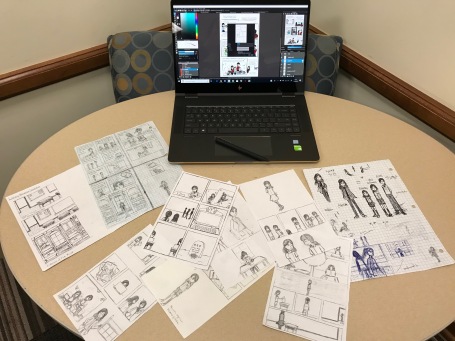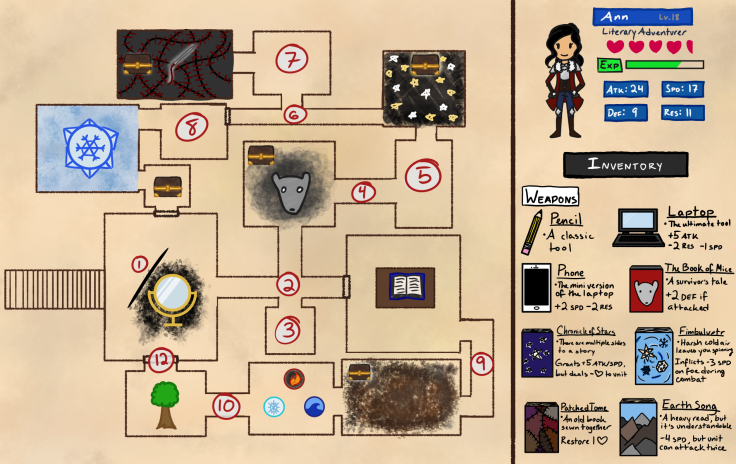First off, welcome! This website is a portfolio of the work I’ve done for my English 101 class with Professor David Morgen in the 2018 Fall semester at Emory University. When I initially read the course description for this class, I was instantly intrigued by the concept of an English class dealing with the analysis of comics: a visual and literary medium that you don’t usually read in your typical academic setting. Aside from a general interest in the medium itself, I took the course hoping to learn more about myself and my writing process since I’m a highly visual thinker. Looking back, this class was a fulfilling challenge that allowed me to explore a subject I barely knew yet ended up identifying with in a way that’s allowed me to become a better writer.
Aside from the personal goal mentioned above, I was tasked with fulfilling 5 course objectives/learning outcomes throughout the semester. The first objective is clearly displayed in the various assignments on this website. Specifically, the Sunday Sketches employed various modes and topics. In the example below, I was tasked with

“telling a true story” in the form of a short comic. As a person who doodles frequently, this task wasn’t hard to conceptualize; the images and story instantly popped in my head. The challenge for me was transferring those visuals to paper. Another sketch assignment I had to do concerned crafting a “self-portrait” through the items in my bag. The task was relatively simple: empty out my bag and take a picture. However, the captions I had to write revealed the true intention of the task.

After listing out all the items in my bag, I had to write a short description for each one. From there, I could understand how this picture was a “self-portrait.” One can easily see the differences and similarities between these two tasks. Though one’s a hand-drawn comic and the other’s simply a picture of junk, they’re both visuals that tell some sort of story, whether that be about a silly event or piecing together a person’s identity. These two sketches represent a small snippet of the variety of mediums and modes used throughout the class.
The first major project I had to do for this class was called “Tracing Maus,” in which I had to choose two pages from Art Spiegelman’s Maus series, analyze them and write about three patterns/themes found in both pages.

This assignment fulfills the fourth learning outcome of “demonstrate visual thinking strategies to analyze and interpret visual information and to experiment, assemble, and arrange visual and written documents of their own.” In the assignment, I had to physically trace a page, which allowed me to clearly recognize the patterns Spiegelman used in his work. From there, I digitally annotated the page in order to effectively color-code my analysis. Under the “Tracing Maus” page, you’ll find the three themes spotted in these two tracings. Overall, this assignment was eye-opening to me because I was actively practicing visual analysis in a literary medium. Practicing visual analysis and recognizing patterns in images is a very important step in my writing process as a visual thinker, though I’ll elaborate more on this subject later.
Another project that I created for this class was a comparison essay between two graphic memoirs: David Small’s Stitches and Tillie Walden’s Spinning. In it, I had to examine the way Small and Walden expressed their respective stories of trauma while using an essay by Hillary Chute as a “guide” in the analysis. Sounds rather complicated right? Well, you aren’t wrong.

Aside from the accident, yellow absorbs the ice skating rink when skating “lost all its shine” (139) and covers the panels on pages 332-334 whenever Tillie messes up her routine and feels anxious or frustrated. Walden methodically uses the contrast between purple and yellow to elicit such feelings of unease and tension in order to better convey her experience of trauma.
For the third learning outcome, “practice writing as a process, recursively implementing strategies of research, drafting, revision, editing, and reflection,” I’d like to talk about the assignment closest to my heart and one of the main reasons why I decided to take this class: The Literacy Narrative. I’ve always been interested in making a comic; I just didn’t know where to start. I signed up for this class hoping to not only learn more about comics but to also make one myself. For me, being able to draw a narrative as a grade was an assignment I could only dream of! Throughout this letter, I’ve been mentioning how I’m a highly visual thinker. This assignment is a demonstration of my thinking and writing process and has allowed me to genuinely convey the ideas in my head. The structure of this assignment was to:
- Think of a memory about writing and write it down as an alphabetic text
- Transform that alphabetic text into a visual narrative
- Modify the alphabetic using the comic
My writing process consisted of:
- Think of a memory, imagining what I saw and felt at the time
- Transform that scene into words
- Draw what the memory looked like in the form of a comic, somewhat using the alphabetic as more of a “to do list”
- Rewrite the alphabetic using the comic
As you can see, there were two very different first steps towards this assignment. For me, the comic was the closest representation to the narrative rather than the text. It would have been easier to perhaps write an outline in bullet points for key moments and jump straight to the comic rather than write the story down itself. Since my writing process consists of me transforming images and emotions into words, drawing a narrative was so much easier, yet it was the most arduous task I’ve done in a while.

I really like drawing, though I’m neither good nor bad at it. It’s easy for me to visualize what I want to draw, but the problem is that I can never create a true representation of that image. This strive for perfection leads to fairly decent results, but also a decent amount of frustration and disappointment. The assignment said that the comic should be about 3-4 pages long; I ended up making it 9 pages in total. needless to say, I bit off a bit more than I could chew. I’d rather stress myself out at 2am than condense my narrative by a page; if I didn’t follow the vision, I’d be completely dissatisfied. And thus I decided to just go for it. The drawing process was long and strenuous, but definitely worth it. It was fun to play with different panel designs implement the analysis and strategies used in class. I must admit, the comic isn’t the perfect representation of the narrative I wanted to tell, but it’s close enough to say that I’m proud of the work I’ve done.
Overall, this class has allowed me to grow as a writer by exposing me to various mediums, challenging my weaknesses, and learning more about my writing process. Through this website, I can see the progress I’ve made throughout the semester along with the fulfillment of the final learning outcome, “employ technology appropriately and engage responsibly in online spaces, be able to explain and practice good digital citizenship, and utilize the concepts of intellectual property.” It was quite the process of creating my own website; before this I had no idea about how to build one. Throughout the semester, I’ve been slowly cultivating my digital portfolio and learning more about how to use WordPress. It’s a very useful tool which I hope to use again. Coming out of this class, I feel as if both I and the class have met my personal expectations. I was able to learn about a medium that has taught me about myself as a writer. I’ll definitely be using the skills utilized in class to better understand my thought process and thus create a better translation of my ideas to words. Nonetheless, this semester was a great adventure, and if you choose to explore the website, I hope you enjoy the work I have archived. Perhaps you too can discover the knowledge this class imparted unto me.